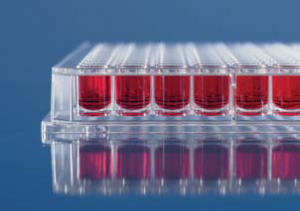Difference Between: 96-Well Plate Bottom Shapes
Bottom shapes of 96-well plates are offered with four distinct bottom shapes.
Bottom Shapes
- U-Bottom; Round-shaped well bottom. As wells with this bottom have no edges they are well suited or stirring and washing of samples. This bottom shape is used for agglutination and other assays requiring these tasks.
- V-Bottom; Conically-shaped well bottom. Sample recovery is maximized with this bottom shape. For this reason plates with V-bottom are especially suited for precipitation assays and storage.
- F-Bottom; Flat well bottom. The F-bottom is designed for precise optical measurements and is well suited for colorimetric determinations as well as microscopy applications. Additionally, the F-bottom is used for specific applications such as cell culture.
- C-bottom; Flat bottom with curved edges. The C-bottom combines the advantages of U-bottom and F-bottom. Because of the curved edges, better sample mixing is obtained. The flat bottom in the middle area of the wells at the same time allows the realization of precise optical measurements. The C-bottom is specially suited for immunological assays, as sample stirring has a major impact on precise assay results as well as optical measurement to determine those results.
The 96-well plate bottom types are available in three surface types including non-treated, immunological, and cell culture surfaces.
The 384- and 1536-well format microplates are only available with the F-bottom shape.
